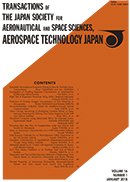最新号
(ISTS Special Issue: Selected papers from the 26th International Symposium on Space Technology and Science)
選択された号の論文の250件中51~100を表示しています
c) Materials and Structures
-
2009 年 7 巻 ists26 号 p. Pc_13-Pc_18
発行日: 2009年
公開日: 2009/05/21
PDF形式でダウンロード (771K) -
2009 年 7 巻 ists26 号 p. Pc_19-Pc_23
発行日: 2009年
公開日: 2009/05/21
PDF形式でダウンロード (625K) -
2009 年 7 巻 ists26 号 p. Pc_25-Pc_30
発行日: 2009年
公開日: 2009/05/21
PDF形式でダウンロード (683K) -
2009 年 7 巻 ists26 号 p. Pc_31-Pc_36
発行日: 2009年
公開日: 2009/05/21
PDF形式でダウンロード (3767K) -
2009 年 7 巻 ists26 号 p. Pc_37-Pc_42
発行日: 2009年
公開日: 2009/06/02
PDF形式でダウンロード (2144K) -
2009 年 7 巻 ists26 号 p. Pc_43-Pc_48
発行日: 2009年
公開日: 2009/06/13
PDF形式でダウンロード (880K) -
2009 年 7 巻 ists26 号 p. Pc_49-Pc_54
発行日: 2009年
公開日: 2009/06/13
PDF形式でダウンロード (1403K) -
2009 年 7 巻 ists26 号 p. Pc_55-Pc_60
発行日: 2009年
公開日: 2009/09/15
PDF形式でダウンロード (557K) -
2009 年 7 巻 ists26 号 p. Pc_61-Pc_66
発行日: 2009年
公開日: 2009/09/15
PDF形式でダウンロード (517K) -
2009 年 7 巻 ists26 号 p. Pc_67-Pc_72
発行日: 2009年
公開日: 2009/09/15
PDF形式でダウンロード (2326K) -
2009 年 7 巻 ists26 号 p. Pc_73-Pc_78
発行日: 2009年
公開日: 2009/09/15
PDF形式でダウンロード (961K) -
2009 年 7 巻 ists26 号 p. Pc_79-Pc_84
発行日: 2009年
公開日: 2009/09/15
PDF形式でダウンロード (682K) -
2009 年 7 巻 ists26 号 p. Pc_85-Pc_91
発行日: 2009年
公開日: 2009/10/22
PDF形式でダウンロード (1117K) -
2009 年 7 巻 ists26 号 p. Pc_93-Pc_98
発行日: 2009年
公開日: 2009/12/17
PDF形式でダウンロード (409K) -
2009 年 7 巻 ists26 号 p. Pc_99-Pc_104
発行日: 2009年
公開日: 2009/12/17
PDF形式でダウンロード (589K) -
2009 年 7 巻 ists26 号 p. Pc_105-Pc_110
発行日: 2009年
公開日: 2010/02/16
PDF形式でダウンロード (432K) -
2009 年 7 巻 ists26 号 p. Pc_111-Pc_115
発行日: 2009年
公開日: 2010/02/16
PDF形式でダウンロード (580K)
d) Astrodynamics, Navigation Guidance and Control
-
2009 年 7 巻 ists26 号 p. Pd_1-Pd_6
発行日: 2009年
公開日: 2009/06/13
PDF形式でダウンロード (433K) -
2009 年 7 巻 ists26 号 p. Pd_7-Pd_16
発行日: 2009年
公開日: 2009/06/13
PDF形式でダウンロード (701K) -
2009 年 7 巻 ists26 号 p. Pd_17-Pd_22
発行日: 2009年
公開日: 2009/10/22
PDF形式でダウンロード (523K) -
2009 年 7 巻 ists26 号 p. Pd_23-Pd_28
発行日: 2009年
公開日: 2009/10/22
PDF形式でダウンロード (1213K) -
2009 年 7 巻 ists26 号 p. Pd_29-Pd_35
発行日: 2009年
公開日: 2009/10/22
PDF形式でダウンロード (553K) -
2009 年 7 巻 ists26 号 p. Pd_37-Pd_42
発行日: 2009年
公開日: 2009/10/22
PDF形式でダウンロード (423K) -
2009 年 7 巻 ists26 号 p. Pd_43-Pd_48
発行日: 2009年
公開日: 2009/10/22
PDF形式でダウンロード (813K) -
2009 年 7 巻 ists26 号 p. Pd_49-Pd_55
発行日: 2009年
公開日: 2009/10/22
PDF形式でダウンロード (777K) -
2009 年 7 巻 ists26 号 p. Pd_57-Pd_62
発行日: 2009年
公開日: 2009/10/22
PDF形式でダウンロード (602K) -
2009 年 7 巻 ists26 号 p. Pd_63-Pd_68
発行日: 2009年
公開日: 2009/11/28
PDF形式でダウンロード (691K) -
2009 年 7 巻 ists26 号 p. Pd_69-Pd_73
発行日: 2009年
公開日: 2009/11/28
PDF形式でダウンロード (451K) -
2009 年 7 巻 ists26 号 p. Pd_75-Pd_80
発行日: 2009年
公開日: 2009/11/28
PDF形式でダウンロード (482K) -
2009 年 7 巻 ists26 号 p. Pd_81-Pd_86
発行日: 2009年
公開日: 2009/11/28
PDF形式でダウンロード (2677K) -
2009 年 7 巻 ists26 号 p. Pd_87-Pd_94
発行日: 2009年
公開日: 2009/11/28
PDF形式でダウンロード (3174K) -
2009 年 7 巻 ists26 号 p. Pd_95-Pd_104
発行日: 2009年
公開日: 2010/01/15
PDF形式でダウンロード (2979K) -
2009 年 7 巻 ists26 号 p. Pd_105-Pd_110
発行日: 2009年
公開日: 2009/12/27
PDF形式でダウンロード (1052K) -
2009 年 7 巻 ists26 号 p. Pd_111-Pd_118
発行日: 2009年
公開日: 2009/12/27
PDF形式でダウンロード (1107K) -
2009 年 7 巻 ists26 号 p. Pd_119-Pd_124
発行日: 2009年
公開日: 2010/05/08
PDF形式でダウンロード (1875K) -
2009 年 7 巻 ists26 号 p. Pd_125-Pd_130
発行日: 2009年
公開日: 2010/06/08
PDF形式でダウンロード (1690K)
e) Fluid Dynamics and Aero-thermodynamics
-
2009 年 7 巻 ists26 号 p. Pe_1-Pe_7
発行日: 2009年
公開日: 2009/08/24
PDF形式でダウンロード (968K) -
2009 年 7 巻 ists26 号 p. Pe_9-Pe_14
発行日: 2009年
公開日: 2009/08/24
PDF形式でダウンロード (613K) -
2009 年 7 巻 ists26 号 p. Pe_15-Pe_24
発行日: 2009年
公開日: 2009/08/28
PDF形式でダウンロード (668K) -
2009 年 7 巻 ists26 号 p. Pe_25-Pe_30
発行日: 2009年
公開日: 2009/09/15
PDF形式でダウンロード (813K) -
2009 年 7 巻 ists26 号 p. Pe_31-Pe_36
発行日: 2009年
公開日: 2009/09/15
PDF形式でダウンロード (895K) -
2009 年 7 巻 ists26 号 p. Pe_37-Pe_42
発行日: 2009年
公開日: 2009/10/22
PDF形式でダウンロード (661K) -
2009 年 7 巻 ists26 号 p. Pe_43-Pe_47
発行日: 2009年
公開日: 2009/10/22
PDF形式でダウンロード (577K) -
2009 年 7 巻 ists26 号 p. Pe_49-Pe_58
発行日: 2009年
公開日: 2009/10/22
PDF形式でダウンロード (921K) -
2009 年 7 巻 ists26 号 p. Pe_59-Pe_64
発行日: 2009年
公開日: 2009/11/28
PDF形式でダウンロード (578K) -
2009 年 7 巻 ists26 号 p. Pe_65-Pe_70
発行日: 2009年
公開日: 2009/11/28
PDF形式でダウンロード (1202K) -
2009 年 7 巻 ists26 号 p. Pe_71-Pe_76
発行日: 2009年
公開日: 2009/11/28
PDF形式でダウンロード (1330K) -
2009 年 7 巻 ists26 号 p. Pe_77-Pe_82
発行日: 2009年
公開日: 2010/12/08
PDF形式でダウンロード (1003K)
f) On-Orbit and Ground Support Systems
-
2009 年 7 巻 ists26 号 p. Pf_1-Pf_9
発行日: 2009年
公開日: 2009/05/01
PDF形式でダウンロード (1184K) -
2009 年 7 巻 ists26 号 p. Pf_11-Pf_16
発行日: 2009年
公開日: 2009/05/21
PDF形式でダウンロード (1098K)
